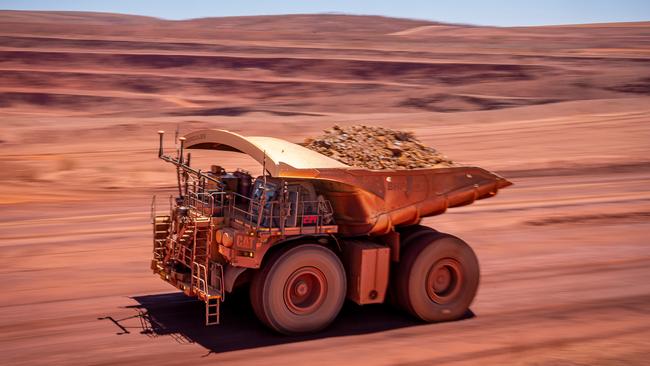BHP chief Mike Henry says the company is set up for decades of growth across its three key pillars
The mining giant’s balance sheet is in fantastic shape and its growth options are much better positioned than they were just a few years ago, CEO Mike Henry says.

Business
Don't miss out on the headlines from Business. Followed categories will be added to My News.
BHP’s balance sheet is in fantastic shape and its growth options are much better positioned than they were just a few years ago, chief executive Mike Henry said on Tuesday, as he addressed questions from shareholders about the global miner’s operations.
During the question and answer forum which followed the release of the company’s full year results in August, Mr Henry said the BHP’s diversification across iron ore, copper and potash was a strong mix given the demand for those minerals in coming years.
“We are so much better placed today than we were a few years ago in terms of growth optionality in the portfolio, both potash and copper,’’ he said.
“A big focus of our results presentation this time was on the copper optionality in the portfolio and revealing more detail about copper growth options in Chile, in copper in South Australia, and more recent acquisitions we’ve made in Argentina.”
Mr Henry said there was a “competition between capital’’ among the various growth options open to BHP, which was “a great conundrum for us to resolve’’.
“In the coming months and years, I’m really optimistic about the growth outlook for the company,’’ Mr Henry said.
The chief executive sidestepped a question about whether copper and potash would bypass iron ore in terms of their contribution to the business in the next decade or so, but pointed out that with a $US10 cash flow premium over its competitors, the WA iron ore operation was performing strongly.
With the growth options in copper, including a proposed expansion of South Australian copper output to more than 500kt by the early 2030s, and the Jansen stage one and two potash projects in Canada set to make BHP one of the largest potash suppliers globally by about 2030, the company was well positioned, Mr Henry said.
“Overall, what that is going to give us is a portfolio that has the world’s lowest cost iron ore business, which has improved product quality as a result of our investment in South Flank,’’ he said.
“We’re currently generating $US10 per tonne more free cash flow than our biggest competitor, so that’s a business that’s going to stand us in good stead.
“Long term, we have a high quality steelmaking coal business in Queensland and increased growth in future facing commodities through potash and copper.
“So this is a very resilient portfolio, one that’s going to allow us to deliver great returns for shareholders over the decades to come.’’
Chief financial officer Vandita Pant said the balance sheet was in “fantastic shape’’, with the debt sitting in the middle of the company’s $US5bn-$US15bn target range.
Responding to a question about why the dividend had reduced in recent years, Ms Pant said BHP’s capital allocation framework mandated a minimum payout ratio of 50 per cent for dividends, with the company then deciding how to allocate the remainder, whether that be towards additional returns to shareholders, growth projects, or to balance sheet strength.
“In the last three years, we have been one of the highest dividend payers across industries globally,’’ she said.
“If I were to include the dividend that we just announced of $US3.8bn with the full year results, our shareholder returns in dividends in the last three years have been $US42bn.”
Ms Pant said share buybacks would continue to be considered, while noting the company last had a share buy back in place in fiscal 2019.
Originally published as BHP chief Mike Henry says the company is set up for decades of growth across its three key pillars



